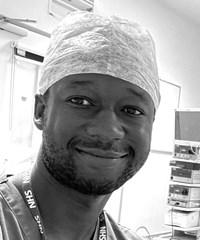ENT features
Cochlear implants for children
The field of cochlear implants in children has expanded remarkably over 40 years. Elizabeth Tyszkiewicz reflects on success and current challenges and calls for a national review of outcomes for young adults who received their implants in childhood. Aleena is...
A surgeon’s perspective on the challenges facing cochlear implantation in children
Cochlear implantation in children offers a different set of challenges and goals to adult practice. In this article, Iain Bruce, Professor of Paediatric Otolaryngology in Manchester, UK, explains some of the current clinical and research challenges in paediatric cochlear implantation,...
Extended benefits of cochlear implantation in the elderly
With the challenges presented by an ageing population, Louise Craddock and Charlie Huins describe the benefits of cochlear implants for deaf elderly adults that go beyond improvement of hearing and speech understanding. Introduction People aged over 65 make up 7.4%...
Genetic research on hereditary hearing loss and clinical application in the Chinese population
Congenital deafness in China affects more people than the entire population of Australia. Prof Wang give us a comprehensive insight into one of the main congenital disabilities in China, looking into the causes of deafness and the benefits of genetic...
ENT Wallabies
Juggling the demands of elite sport, a boisterous social life on tour and medical academia would seem too much for mere mortals. All in a day’s work for your average Wallaby. Currently I am a Senior Visiting Medical officer at...
The National Bone Conducting Hearing Implant Registry
Are you an otologist with an interest in implant surgery? Is your unit on the registry? If not, you’d better have a good excuse after reading this… What is the National BCHI Registry? The National Bone Conducting Hearing Implant (BCHI)...
Tone deafness and perfect pitch
If you think you are tone deaf, do not despair. Singing tuition should help but it is probably too late to hope to develop perfect pitch. Consultant otolaryngologist and keen musician, Chris Aldren, discusses the complex and fascinating subject of...
General overview of endoscopic ear surgery: advantages and principles
The philosophy of endoscopic ear surgery presents surgeons with a tricky concept – does the magnificent view make up for the fact I need to operate with one hand? In this article, Jane Lea discusses the advantages of operating transcanal...
Staying safe during endoscopic ear surgery
There is growing interest in using rigid endoscopes rather than traditional operative microscopes to perform transcanal middle ear surgery. Rigid endoscopy provides a high resolution, wide-angle view of the tympanic cavity through minimally invasive surgical portals. In this article, Elliott...
Video otology tutorials: how EES changes the game
High definition endoscopic ear surgery (EES) redefines traditional middle ear anatomical perspectives. The surgeon can observe in situ anatomical relationships with angled objectives in a way that the traditional microscopic view, with step-wise removal of structures is unable to achieve....
Endoscopic ear surgery in children
The benefits of endoscopes in otologic surgery, which have become increasingly widely appreciated in recent years, are very well suited to the management of paediatric middle ear disease. Although one might imagine that the smaller ear canal of a child...
TWJ Fellowship – Toronto 2015: Endoscopic Ear Surgery
The Thomas Wickham Jones (TWJ) Foundation is a charitable trust with the aim of helping patients with deafness overcome their disability. Striving to achieve this goal they provide educational grants to otolaryngologists and other related audiological professionals working within the...




















